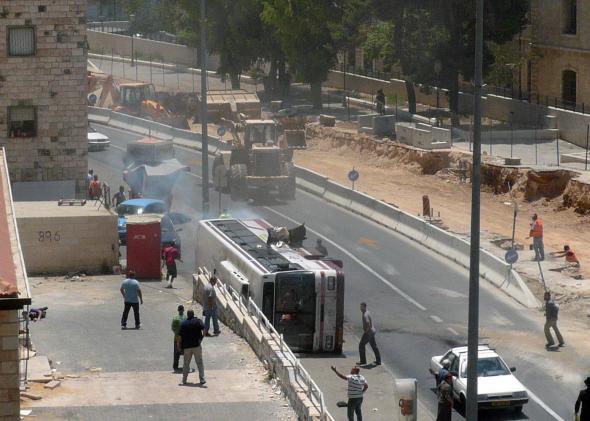Earlier today a Palestinian man who Israeli police say had connections to Hamas drove a car into a crowd near a light rail station in Jerusalem, killing one person and injuring a dozen others. It followed a strikingly similar attack in the same area two weeks ago that killed a 3-month-old Israeli. In both cases, the driver was killed by police at the scene.
These attacks are the latest manifestations of the current atmosphere of violence and tension in Jerusalem. They are also the latest examples of a terrorist tactic that gets less discussion than many others but seems increasingly common, particularly in Israel.
Ramming attacks have been a weapon in the arsenal of Palestinian terrorists for some time now. During last summer’s fighting in Gaza, for instance, a construction excavator was used to attack a bus in Jerusalem, earning the praise of a Hamas spokesman.
In 2011, when a stolen taxi rammed into a police roadblock outside a club in Tel Aviv, injuring seven, the Jerusalem Post reported that it was the fifth attack of its kind in the past three years. The worst of these was the 2008 bulldozer attack in Jerusalem that killed three people and injured dozens of others.
“It’s obviously an inferior tactic to bombings,” Daveed Gartenstein-Ross, a counterterrorism researcher at the Foundation for the Defense of Democracies, told me, noting that one attacker died for every victim in both of the recent incidents. “In Israel, part of the reason you’re seeing it adopted is that the security barrier is fairly effective, which makes it hard to get bombs into the country.”
While the tactic may be most common in Israel, it’s appeared elsewhere as well. Two weeks ago a Canadian man believed to be an ISIS sympathizer drove his car into two soldiers in a parking lot in Quebec. In Beijing last year, three Uighurs drove a jeep into Beijing’s crowded Tiananmen Square, killing two and injuring about 40. In 2006, Mohammed Reza Taheri-Azar, a recent University of North Carolina graduate, drove an SUV into “The Pit,” a popular campus gathering spot, injuring nine people. He told police after his arrest that he had wanted to “avenge the deaths or murders of Muslims around the world.”
A variation on ramming attacks is also recommended in the fall 2010 issue of Inspire, the English-language online magazine published by al-Qaida in the Arabian Peninsula. The magazine, which was read by the Tsarnaev brothers and is known for advice columns like “Build a Bomb in the Kitchen of Your Mom,” suggests that jihadis attach sharp steel blades or butcher’s knives to the front of a 4-by-4 pickup truck to create “a mowing machine, not to mow grass but mow down the enemies of Allah.”
The article recommends that practitioners take care to gather enough speed to “achieve maximum carnage” once crowds begin to scatter, and to choose their targets carefully. “If you can get through to ‘pedestrian only’ locations that exist in some downtown (city center) areas, that would be fabulous,” the author, editor-in-chief Yahya Ibrahim, writes. He also suggests a number of countries where such an attack could take place, including the U.S., Britain, Canada, Australia, France, Germany, Denmark, and Holland. So far, thankfully, no one seems to have attempted an attack along these lines.
What ramming lacks in effectiveness, it makes up for in ease of preparation. It’s not hard to get your hands on a car, and driving one at high speeds into a crowd is a lot easier than building a bomb. Inspire notes that it is “a simple idea and there is not much involved in its preparation.” In a 2010 advisory, the FBI suggested that it “offers terrorists with limited access to explosives or weapons an opportunity to conduct a Homeland attack with minimal prior training or experience.”
Its crude simplicity makes it a tactic more likely to be employed by relatively unskilled “lone wolves” than organized and trained terrorist operatives. But like with many amateur terrorist tactics, the effect is as much psychological as physical. It sends the message that objects we take for granted can be transformed into weapons at the blink of an eye.
